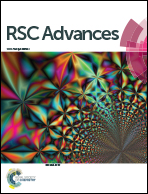Anodic SnO2 porous nanostructures with rich grain boundaries for efficient CO2 electroreduction to formate†
Abstract
Formic acid (HCOOH), the acidic form of formate, is an important hydrogen carrier which can be directly used in fuel cells. Development of earth-abundant element-based catalysts to convert carbon dioxide (CO2) into HCOOH or formate with high selectivity and high efficiency has been a vigorous research activity in recent years but remains an unsolved challenge. In this contribution, using one-step anodization, we prepare nanotubular SnO2 porous nanostructures with high surface area (90.1 m2 g−1), large porosity (0.74 cm3 g−1), and rich grain boundaries for electrochemical CO2 reduction (CO2RR). They exhibit stable 95% faradaic efficiency (FE) towards CO2RR and 73% FE for formate at −0.8 VRHE. The notable performance of such SnO2 nanostructures can be attributed to their unique structural and chemical properties, which provide active sites for CO2 adsorption and conversion, and easy access for CO2 to the active sites. The insights gained from the structure/property relationships might be beneficial for designing superior electrocatalysts for CO2 electroreduction into formate.



 Please wait while we load your content...
Please wait while we load your content...